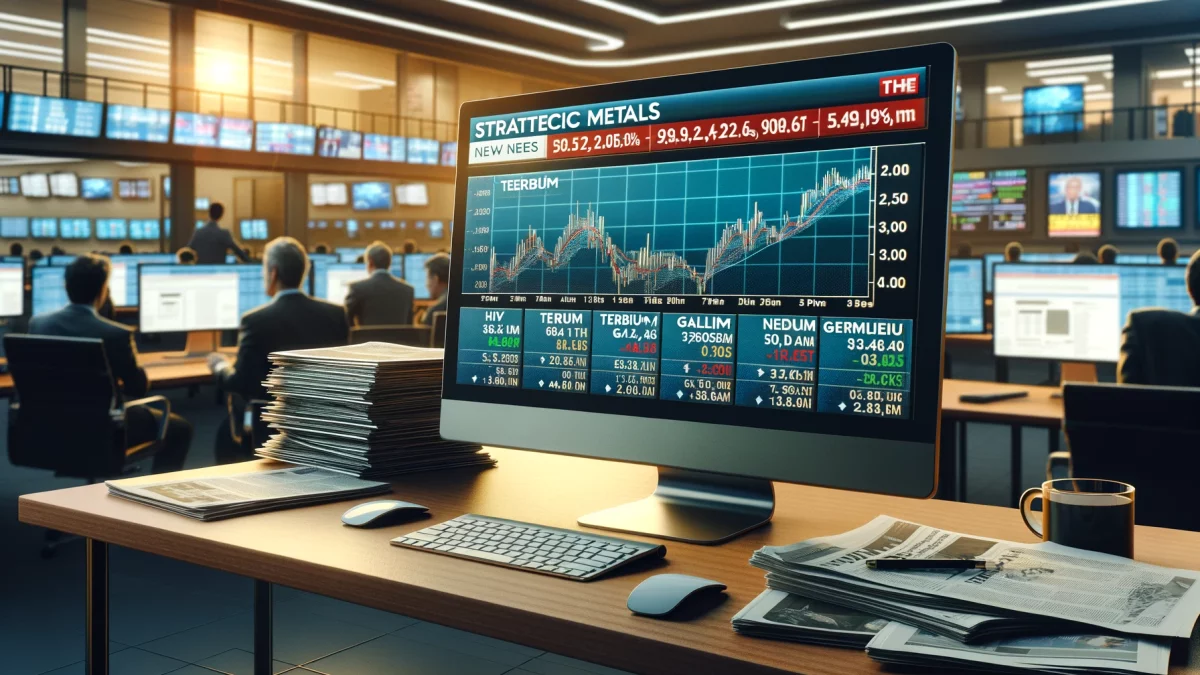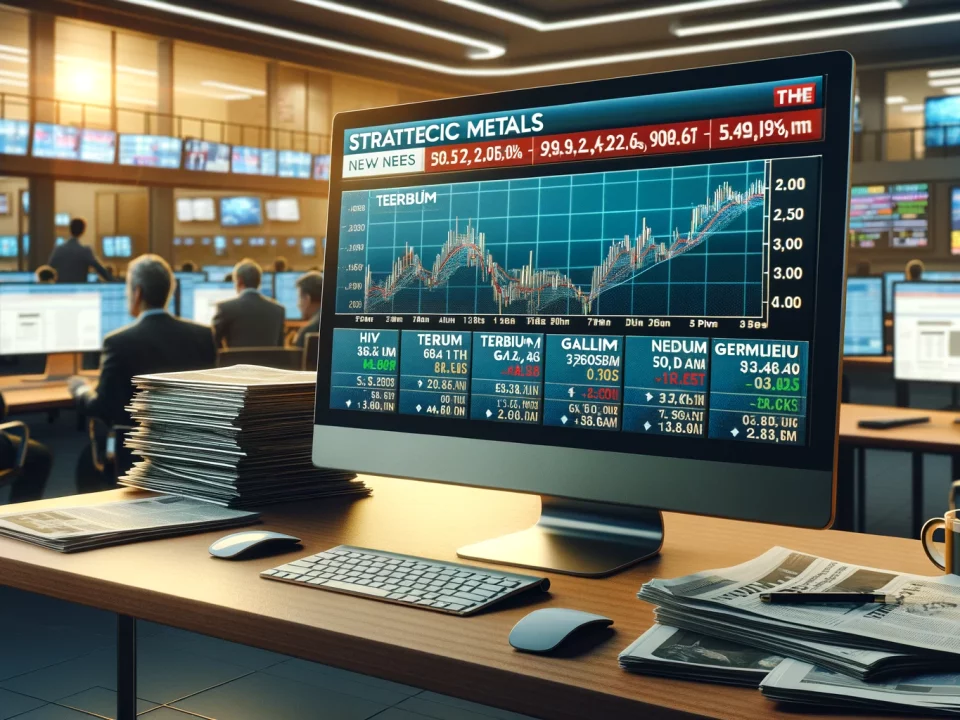
Weekly News Review September 23 – September 29 2024
September 29, 2024
Hafnium Price Forecast for 2025 and Beyond: Long-Term Growth Despite Recent Price Corrections
October 9, 2024Welcome to our weekly news review.
USA: DEPT. OF ENERGY GIVES GREEN LIGHT FOR WYOMING FACILITY.
Rare Element Resources is building a processing and separation demonstration plant.
US critical minerals company Rare Element Resources (RER) has received approval from the Department of Energy to begin operations at its rare earth processing and separation demonstration plant in Upton, Wyoming. The Department’s Office of Energy Efficiency and Renewable Energy has issued the second and final continuation notice following its approval of the operations budget and confirmation of readiness.
The plant is now set to go online in the fourth quarter of 2024, provided the US Nuclear Regulatory Commission also gives the green light. The DOE also approved an increase in the project’s cost-share budget to $53.6 million, with federal cost-share increasing by 10% to roughly $24.2 million.
RER is developing the Bear Lodge rare earth mine in northeastern Wyoming. Once mined, rare earth-bearing ores must be separated and refined through different chemical processes. In 2020, RER produced the first neodymium-praseodymium oxides from sample feedstock originating from Bear Lodge.
The company said that the demonstration plant will enable RER to collect the necessary data to begin work on a commercial-scale facility once operational. Should it prove viable, RER is set to mine rare earths and refine them directly into oxides (PDF), which could supply other North American companies.
American Rare Earths, another company based in Wyoming, also recently secured government support, setting the state up to become a significant rare earth hub.
USA AND NORWAY DEEPEN COOPERATION ON STRATEGIC METALS:
The two countries signed a Memorandum of Cooperation on “High-Standard, Market-Oriented Trade.”
The United States and Norway have reaffirmed their cooperation on critical minerals. On Monday, Secretary of State Antony Blinken and Norwegian Foreign Minister Espen Barth Eide signed a Memorandum of Cooperation on “High-Standard and a Market-Oriented Trade of Critical Minerals” in Washington.
Blinken said in a social media post that under the agreement, the two sides will work on secure, transparent supply chains that advance labor and environmental standards.
During the signing ceremony, Minister Eide highlighted Norway’s mineral industry, pointing out that the northern European country is the number one exporter of cobalt to the US and the number three exporter of nickel. Eide added that Norway is the largest graphite producer in Europe.
In June, Norway reported on Europe’s largest rare earth deposit in the country’s south. In addition, the government seeks to open up its maritime waters for deep-sea mining, a controversial yet promising move, as the continental shelf holds vast amounts of resources. Norway could thus become an essential supplier of critical minerals to the US.
The now-signed agreement builds on a deal made in April when the two sides announced that they would collaborate on critical mineral and clean energy supply chains.
USA AND INDIA TO STRENGTHEN SUPPLY CHAIN FOR STRATEGIC METALS:
The trade ministers of both countries signed a Memorandum of Understanding. Cooperation in strategic sectors such as semiconductors and aerospace has already intensified recently.
India and the USA want to strengthen bilateral supply chains in critical minerals for the energy and mobility transition. Indian Commerce Minister Piyush Goyal and his US counterpart Gina Raimondo signed a Memorandum of Understanding in Washington on Thursday. Their meeting was part of the U.S.-India CEO Forum, which brings together leading representatives of the two countries’ economies.
In a subsequent speech, Goyal named the development of technologies and the promotion of investment flows in the green energy sector as objectives of the new agreement, in addition to establishing supply chains. Mineral-rich third countries in Africa and South America are also to be included.
However, as Reuters writes, the MoU “falls far short” of a comprehensive raw materials agreement, such as the one the USA has signed with Japan. This gives Japan access to the tax benefits of the Inflation Reduction Act, a US subsidy package for climate-friendly technologies such as electric cars.
India and the USA have intensified their cooperation in recent months, partly to establish a counterweight to China. Both countries want to become less dependent on the giant of raw materials through domestic mining and new partnerships. India also positions itself as an emerging economic power and potential future competitor to China, particularly in the technology sector.
Just a few days ago, US President Joe Biden and India’s Prime Minister Narendra Modi signed an agreement to jointly build a semiconductor factory on the subcontinent (we reported). At the end of June, the two countries joined forces to cooperate more closely in strategic sectors such as semiconductors, space, telecommunications, artificial intelligence, and clean energy.
UNITED KINGDOM: BRITISH GOVERNMENT PURCHASES SEMICONDUCTOR FACTORY:
Supply chains for national security are being considered. A US company previously owned a struggling domestic facility for gallium arsenide semiconductors.
The United Kingdom has acquired a domestic factory for gallium arsenide semiconductors previously owned by US company Coherent Inc. According to Reuters, the plant had been in financial difficulty, and the purchase price is estimated at $27 million.
The British government stated that this strategic investment aims to strengthen the nation’s defense supply chain. The facility in Newton Aycliffe, Northern England, now renamed Octric Semiconductors UK following the acquisition, is the only secure domestic manufacturer of gallium arsenide semiconductors. These materials are used to enhance fighter jets, among other applications.
Many other technologies today rely heavily on semiconductor chips made from raw materials like gallium and silicon. Due to their essential role and dual-use potential for civilian and military purposes, semiconductors are now considered critical for national security. The UK and other countries have developed their semiconductor strategies, and these high-tech components have become a focus of geopolitical tensions.
The US implemented export controls two years ago to limit China’s access to advanced chips. In response, China introduced export restrictions in the summer of 2023 on crucial semiconductor materials, such as gallium and germanium.
UNITED KINGDOM: IONIC TECHNOLOGIES SECURES GOVERNMENT GRANTS:
Magnet recycling partnerships to be advanced.
Ionic Rare Earth’s subsidiary, Ionic Technologies, has secured two grants totaling $1.7 million from the UK government to advance the European rare earth supply chain (PDF). The first grant aims to expand the partnership between Ionic and fellow UK-based metal and alloy manufacturer Less Common Metals (LCM) and Germany-based magnet manufacturer Vacuumschmelze (VAC) to produce magnets from recycled rare earths:
Ionic plans to recover rare earth oxides from magnetic swarf supplied by VAC. The oxides are then reduced to metals and alloys by LCM to re-supply VAC’s magnet production.
The second grant seeks to propel a joint project by Ionic, the Materials Processing Institute, and Swansea University to establish better methods to demagnetize end-of-life rare earth magnets. According to the company, faster and more efficient demagnetization reduces recycling costs.
Ionic began full-scale production at its demonstration rare earth recycling plant in Belfast earlier this year (we reported). The first magnet feedstock was sourced from decommissioned wind turbines.
As a joint venture with LCM and automotive manufacturer Ford, the plant is set to receive a steady supply of end-of-life magnets, including from electric vehicles. Ford aims to produce 600,000 electric cars in Europe annually by 2026; 70 percent of these are set to contain components originating from its drive train manufacturing plant in Halewood, UK. Oxides produced by Ionic and refined by LCM are set to supply the plant.
GERMANY: STRATEGIC METALS FUND LAUNCHES –
Applications are now open.
The Federal Ministry for Economic Affairs and Climate Action (BMWK) announced on Wednesday that the German government’s raw materials fund is moving into implementation. The fund, endowed with one billion euros, is intended to support projects that contribute to securing the German and European raw material supply through extraction, processing, or recycling.
Applications can now be submitted to the state development bank Kreditanstalt für Wiederaufbau (KfW), which can participate in raw material projects domestically and abroad on behalf of the federal government. Only critical or strategic raw materials are eligible, as defined by the EU’s Critical Raw Materials Act (CRMA), which came into force this year.
According to BMWK, many of these resources, needed for green and digital technologies and the defense industry, are expected to face significant supply shortages. At the same time, there are often strong import dependencies on individual countries.
According to the ministry, the Raw Materials Fund will use diversified financing, particularly equity instruments. According to the KfW, the financing budget per project could range between 50 and 150 million euros. In collaboration with the German Raw Materials Agency (DERA), the development bank is now expected to make an initial selection and present it to the federal government in the coming weeks.
As we reported, the fund launch had been uncertain, even though securing raw materials is considered one of the critical factors for Germany’s competitiveness. According to a study by the German Economic Institute (IW), strategies and funds for raw materials from the EU and the German government must quickly show results.
German investments in foreign mining companies have sharply declined over the past decade. However, the IW questions the fund’s financial scope, noting that other countries, such as France and Italy, have each allocated over two billion euros for comparable measures, a figure also mentioned when the German Raw Materials Fund was first announced in April 2023.






